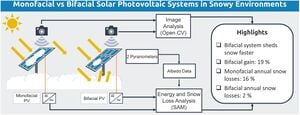
There has been a recent surge in interest in the more accurate snow loss estimates for solar photovoltaic (PV) systems as large-scale deployments move into northern latitudes. Preliminary results show bifacial modules may clear snow faster than monofacial PV. This study analyzes snow losses on these two types of systems using empirical hourly data including energy, solar irradiation and albedo, and open-source image processing methods from images of the arrays in a northern environment in the winter. Projection transformations based on reference anchor points and snowless ground truth images provide reliable masking and optical distortion correction with fixed surveillance cameras. This allows individual PV module-level snow shedding ratio determination as well as average cumulative snow load by employing grayscale segmentation. The data is used to determine the no-snow losses of two systems during summer and snow losses during winter. The results found monofacial snow losses are in average 33% for winter period, and 16% on an annual basis. Bifacial systems perform better than monofacial in severe winter conditions as average winter snow losses was 16% and the annual losses were 2% in the worst-case scenario. In addition, there was a bifacial gain of 19% compared to monofacial system during winter.
- Data and source code https://doi.org/10.17605/OSF.IO/KN57T.
Videos[edit | edit source]
See also[edit | edit source]
- The Impact of Snow Losses on Solar Photovoltaic Systems in North America in the Future
- Snow Losses for Photovoltaic Systems: Validating the Marion and Townsend Models
- A new method to determine the effects of hydrodynamic surface coatings on the snow shedding effectiveness of solar photovoltaic modules
- Impact of Snow and Ground Interference on Photovoltaic Electric System Performance
- Prediction of energy effects on photovoltaic systems due to snowfall events
- Open Solar Outdoors Test Field
- Outdoor data acquisition
- Queen's Innovation Park Test Site
- Solar resource measurement for PV applications
- Performance of Bifacial Photovoltaic Modules on a Dual-Axis Tracker in a High-Latitude, High-Albedo Environment
- Differences in Snow Shedding in Photovoltaic Systems with Framed and Frameless Modules
- Image Analysis Method for Quantifying Snow Losses on PV Systems
- A Review of the Effects of Haze on Solar Photovoltaic Performance
- ---
- OS Computer Vision for Distributed Recycling and Additive Manufacturing
- Additional OS Computer Vision Applications
In the News[edit | edit source]
- Bifacial solar modules shine in snowy environments PV Magazine USA 184.7k
- PV Magazine International 55.2k
- Production des modules monofaciaux vs. bifaciaux en environnement neigeux PV Magazine France
- Technology Times PK 303k
- Bifaciální solární moduly svítí v zasněženém prostředí VT Auta CZ
- Inside Clean Energy: Think Solar Panels Don't Work in Snow? New Research Says Otherwise Inside Climate News














